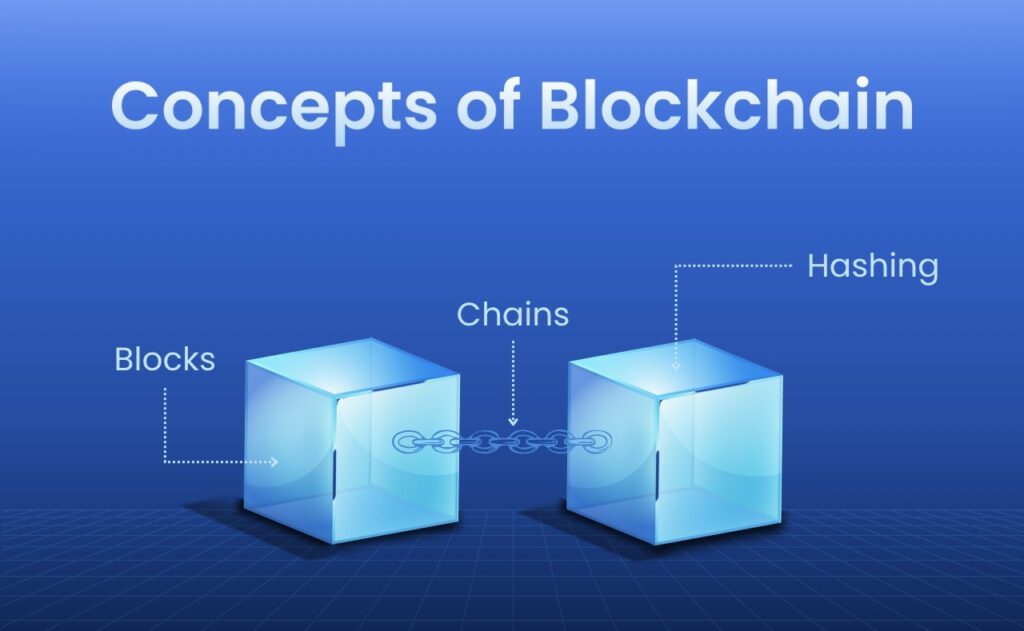
Blockchain is one of the most significant issues in technology today. Although blockchain was originally designed for cryptocurrency, like Bitcoin and Ethereum, its applications extend to innumerable industries, including finance, healthcare, supply chains, and voting systems, to say the least. Theoretically, at a high level, blockchain technology consists of three components: blocks, chains, and hashing. While these components may sound technical, blockchain technology is easy to understand once awkwardly layered together. We will demystify what these components are in simple terms and relate how they work together to provide security, transparency, and trust in blockchain systems.
What is Blockchain?
Prior to covering the three important ideas, let us first review the fundamentals. A blockchain is a digital ledger, a kind of notebook or a journal, that records transactions or other bits of information. As opposed to a located ledger, because a blockchain ledger is located across many nodes, a network of computers. In the network, everyone shares a ledger copy. When a transaction occurs, it shows up on all users’ copies. This decentralized model enables the blockchain to be transparent because everybody can examine the transactions. It is secure because an individual doesn’t control the data, and it is tamper-proof, meaning that if one record were to be modified, it would affect all other records. Now, let’s look at the three building blocks, Blocks, Chains, and Hashing, that make it all possible.
Understanding Blocks

A block is the simplest and one of the main units of a blockchain system, like a page in a notebook or a record in a database. It serves as a secure container for storing information. Each block has important components, which include the data (or various transactions) for instance, sender, receiver, and amount in Bitcoin or records for other use cases the timestamp of when it was created, and the hash from the previous block that ties it to the block that comes before it, and a nonce and hash that are unique codes used to identify and secure the block in the blockchain.
Example: To clarify, think of you and your friends tracking your expenses every day, in this case, how it is who spent what. Each day’s expenses – or record – represents that day’s block, you would take a page and fill it with the expenses. At the end of the day, you would ‘seal’ that page, such that no one can change their expenses recorded, so it is permanent. The next day, you would begin another page that linked back to the previous page, thereby creating what is referred to as a chain of blocks that are linked (i.e., unchangeable). This is how a blockchain works.
Blocks are important because they provide an organized method to store information, help prevent changing the data (once recorded), and provide trust or structure to the entire blockchain.
What Does the “Chain” Mean?

Now that you are familiar with the block, we can discuss what it means to be a chain. Chain refers to how these blocks are connected to one another. Each time a block is added to the chain, it contains a unique reference to the previous block, known as a hash. This means that there is a continuing and unbroken history of information, starting with the first block known as the genesis block, to the most current block.
Example: You may think of this as a train. Each car on the train is a block. Each car connects to the car before it and the car after it, forming a complete line. If someone wanted to take a car out of the middle, it would break the whole train. The same is true for block data. If someone wants to alter the data in a block, it breaks the hash they created and links it to the next block, and it is obvious that someone changed the block data.
The chain is essential because it maintains the integrity of the whole blockchain. The chain maintains a defined chronological order of events, from the time the first transaction was recorded to the most recently recorded transaction. The chain also allows blockchain to be tamper-evident, which means if someone were to change a transaction, it would be immediately apparent to everyone in the network. Simply put, the chain connects every block in a secure, trackable, and transparent way.
What is Hashing and Why is It Important?

Hashing is a fundamental component of the strength and security of blockchain. A hash is essentially a digital fingerprint or code that is generated by a mathematical algorithm. A hash can take in any type of input, including all of the data inside a block, and make it into a fixed-length string of letters and numbers. Additionally, regardless of the size of the input, the hash will always be the same length.
For instance, if you typed the word “Hello,” the hash might be a long string of random gibberish. If you change just one letter out of “Hello” to say “hello” with a lowercase h, then the entire hash will change. This makes it impossible to reverse engineer the data or any kind of input before the hash, or to find multiple different inputs that hash into the same hash.
Each block in the blockchain contains its own hash, which is determined by the contents of that block and the hash of the previous block. When a block is created, its hash is generated and recorded for reference. If someone were to change any part of the block, no matter how small, the hash would change immediately, and the link to the next block would be broken.
Hashing is very important because it provides data integrity, provides a secure link to the subsequent block, and provides a unique identity to each block. This process is what allows the blockchain to be trustworthy, immutable, and difficult to fraud.
How Blocks, Chains, and Hashing Work Together
- Transactions occur: People send or receive data, such as cryptocurrency or other digital information, which starts the process of recording on the blockchain.
- Grouped into a block: Once enough transactions happen, they are collected together into a single block that will be added to the blockchain.
- Block gets a hash: A unique digital fingerprint, called a hash, is created for the block to identify and secure it.
- Connected to the chain: Each block includes the hash of the previous block, linking them together in a continuous, unbreakable chain.
- Network verification: Other computers (nodes) in the blockchain network check the new block to ensure all data and hashes are valid.
- Permanent addition: Once verified, the block is added to the blockchain permanently and cannot be altered or deleted.
- Tamper-proof: If anyone tries to change the data, the block’s hash changes, breaking the chain and triggering rejection by the network.
- Result: This system keeps blockchain secure, transparent, reliable, and trustworthy for all participants.
Don’t miss a block in the chain — get fresh blockchain insights delivered to your inbox
Get UpdatesMining and Proof of Work (Simplified)
In many blockchains, such as Bitcoin, new blocks are added by means of mining. Miners are special computers that compete against each other to solve mathematical puzzles that are difficult to solve. When a miner solves a puzzle, a new block is created, and the miner earns a reward, usually in cryptocurrency. Each puzzle involves finding a number, called a nonce, that makes the hash of the new block meet certain rules, like starting with a specific number of zeros. This process is called Proof of Work (PoW). PoW means that it requires a large investment of energy and time to create a block, and it helps protect the network from being altered or from spammy transactions, and it adds an extra layer of security. In order to change the past transaction referenced in a block, a malicious person would have to redo all of the work for all of the blocks back to that transaction, which is almost impossible.
Why Blockchain is Trusted
The trustworthiness of blockchain is due to the collaborative harmony of blocks, chains, and hashing that work to create a secure and reliable environment. It is decentralized, meaning that it is not a single entity or organization that controls it. It is indexed, allowing all actors to see the same data from their distributed access points. Once data is added, it cannot be changed and is immutable. Hashing ties the functionality of each block together with the subsequent block, rendering it safe. Each transaction is verified by multiple computers on the network. This makes the utility of blockchain more than just about cryptocurrency; it has clear utility for supply chain tracking, healthcare records, voting, and digital identity.
Challenges and Limitations
Even though blockchain is a powerful invention, it still has limitations. Some issues are:
- Energy consumption: The Proof of Work algorithm consumes a lot of electricity.
- Scalability: More blocks can cause the network to be laggy.
- Storage: The blockchain continues to grow (exponentially) and needs more storage in a database.
- Complexity: It can take knowledge and time to learn and implement a blockchain.
Nonetheless, many new and exciting updates are happening in the blockchain realm, like Proof of Stake (PoS) and Layer 2 networks, to address each problem.
Why Blockchain is Secure and Transformative
Blockchain might seem complicated at first, but it is actually built on three simple yet powerful principles: blocks, chains, and hashing. Blocks are essentially containers that store information, such as transaction details, records, or any type of digital data. Chains connect these blocks in a specific order, forming a continuous and secure sequence that makes it easy to track the flow of information. Hashing adds another layer of protection by creating a unique digital fingerprint for each block, ensuring that the data cannot be altered without detection. When blocks are connected through chains and secured with hashing, they form a system that is transparent, trustworthy, and extremely difficult to tamper with. Understanding how these three elements work together allows you to see why blockchain is not just a technology for cryptocurrencies like Bitcoin and Ethereum, but a revolutionary tool that drives blockchain software integration and has the potential to transform industries such as finance, healthcare, supply chain management, voting systems, and beyond. By combining security, transparency, and decentralization, blockchain provides a way to manage data and transactions with confidence and efficiency, making it one of the most promising technologies of our time.
Blockchain is a digital ledger that records transactions securely across many computers, making it transparent and tamper-proof.
The core components are blocks (data storage), chains (connections between blocks), and hashing (security mechanism).
Hashing creates a unique digital fingerprint for each block, ensuring data cannot be altered without detection.
Each block contains the hash of the previous block, forming a secure chain of records.
Its decentralization, hashing, and network verification make blockchain resistant to fraud and tampering.
Blockchain is used in finance, healthcare, supply chain tracking, voting systems, and digital identity management.







